Abstract
1. We have investigated the possibility that individual lateral vestibulospinal tract (LVST) axons branch so as to innervate more than one spinal cord level.
2. LVST cells in Deiters' nucleus were activated antidromically by means of electrical stimulation applied through fine metal electrodes inserted into the spinal cord. Both by directly measuring the spread of effect of stimulus current, and from theoretical considerations (Appendix), we determined that in most cases an estimate of spread of effect of stimulus current was 10 μm/μA. From the magnitude of the threshold stimulus and from the location of the stimulus point we could often exclude the possibility that the stimulus was spreading to the LVST instead of activating local branches.
3. Movable stimulating electrodes, or multi-electrode arrays placed in fixed position, were used to activate 115 LVST neurones antidromically by stimulation of local branches in the lower cervical or upper thoracic cord. Of these cells, 50% were also fired antidromically by stimulation of the LVST at levels ranging from L1 to L4 (Lc cells). The remaining cells were not activated by the lumbar stimulus (C cells). An additional group of cells was only fired by the lumbar tract stimulus (L cells).
4. The distribution of locations of Lc cells within Deiters' nucleus more closely resembles that of L cells than that of C cells. In addition the median conduction velocity of Lc cells is similar to that of L cells, but higher than that of C cells.
5. Much of the information reaching the lower cervical level from neurones of the LVST is information that is also simultaneously being passed downward to the lumbar region. Such integration makes it possible for a single neurone to be used to co-ordinate widespread motor activity.
6. A theory is presented in a separate section (Appendix) to account for the spread of effect of stimulus current upon a myelinated axon submerged in an isotropic medium. The threshold for stimulation of a node by a nearby monopolar electrode is predicted to be proportional to the electrode-node spacing. The constant of proportionality is given in a closed form that depends on the electrical properties of both the neurone and the surrounding medium. The predictions of the theory are shown to be in good accord with the experimental results.
Full text
PDF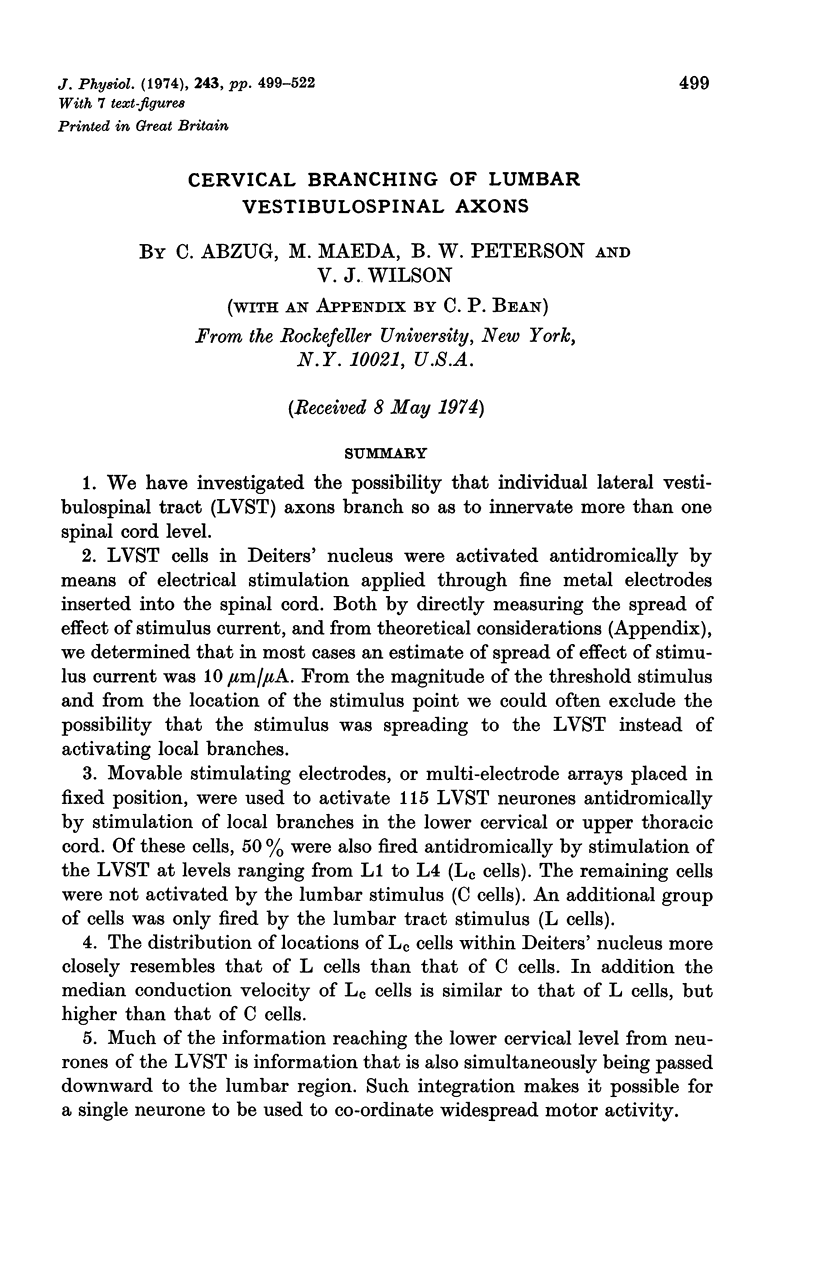
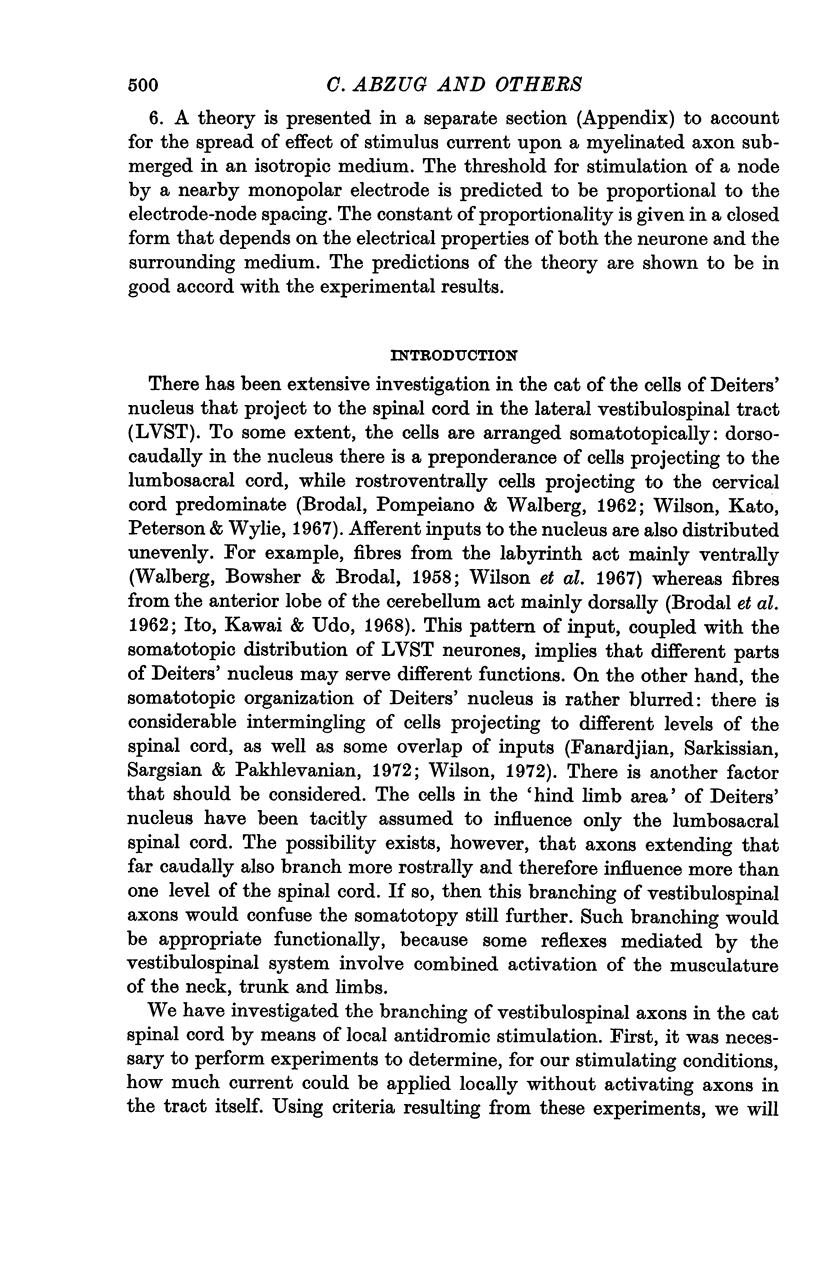
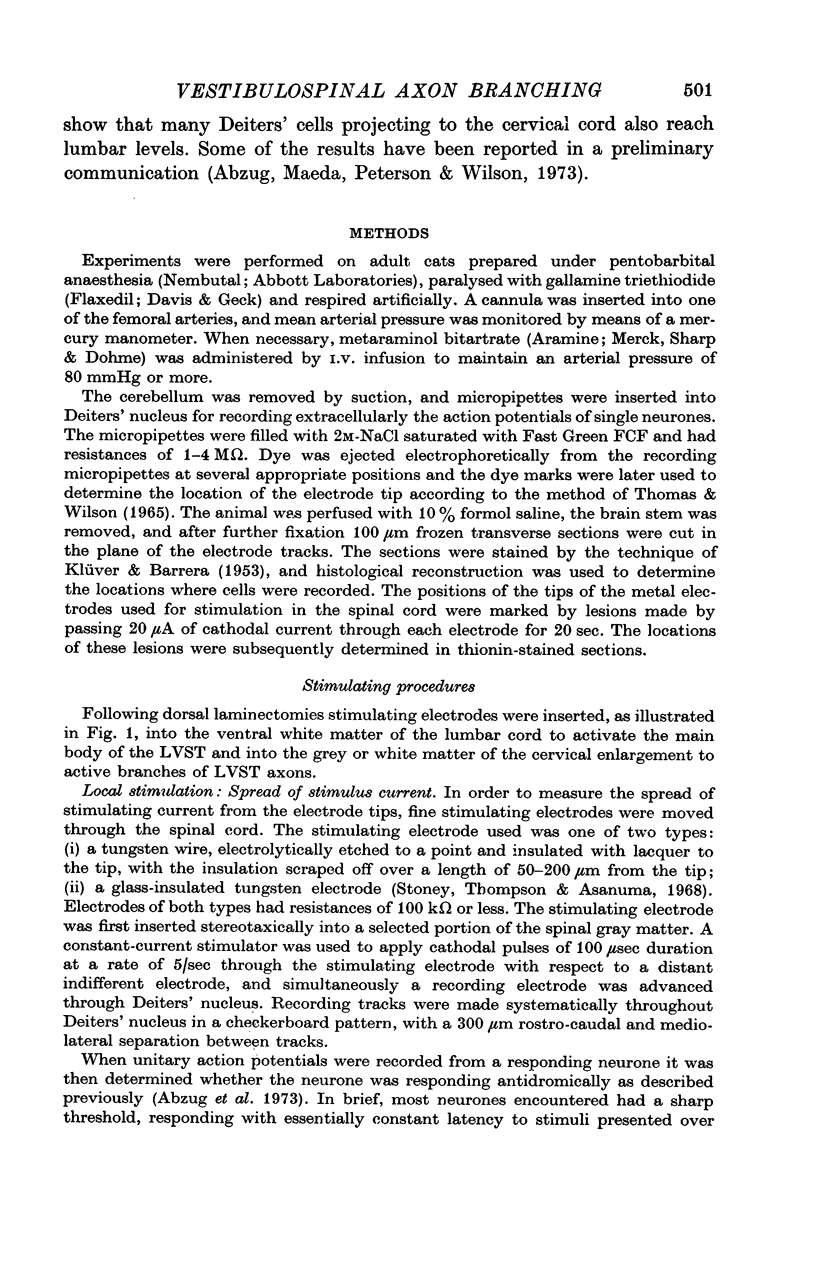
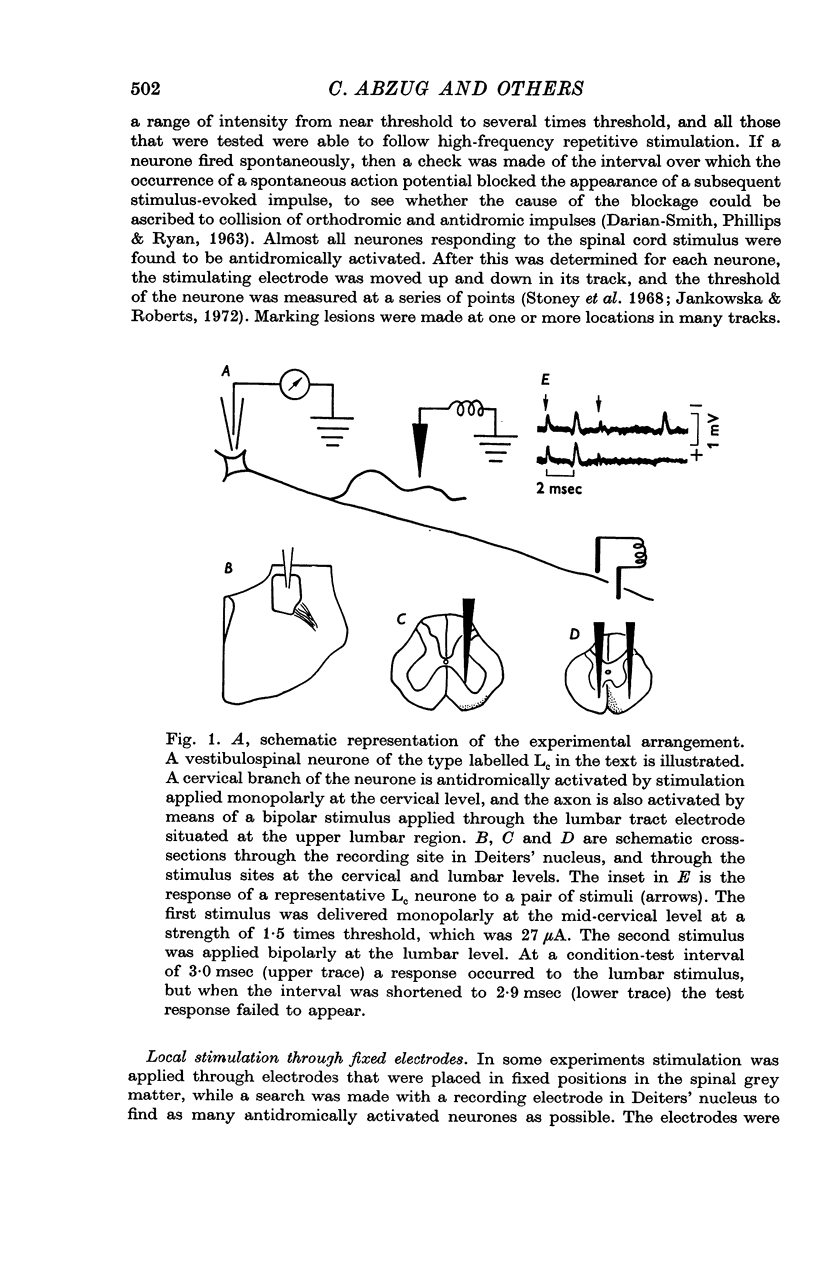
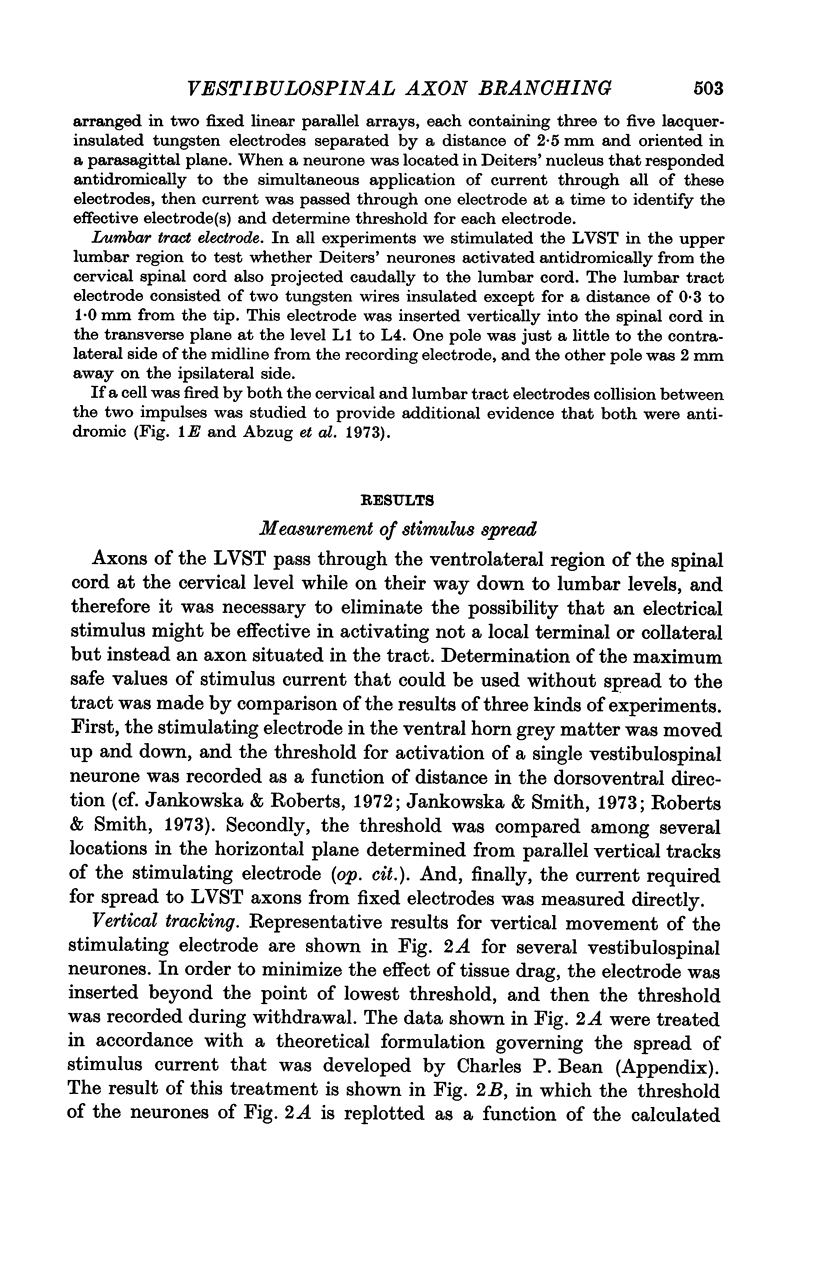
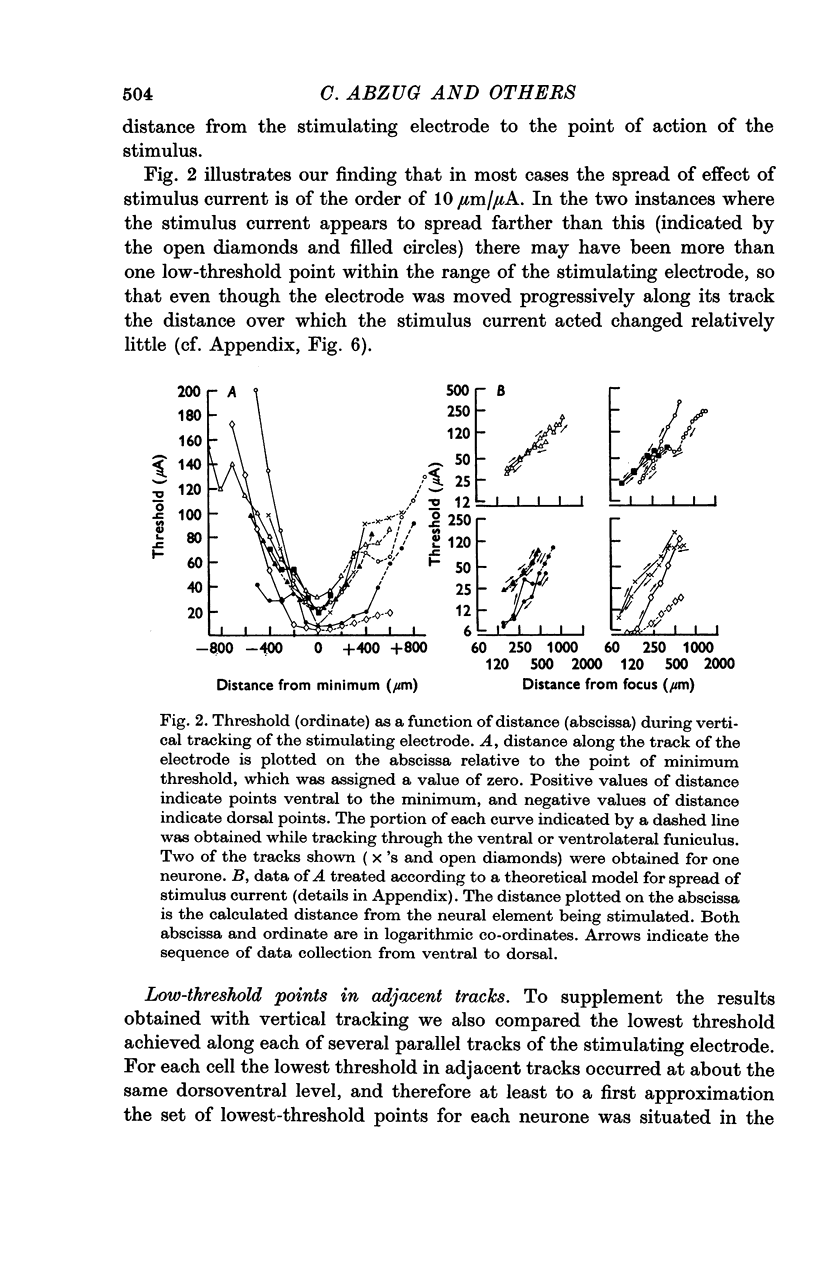
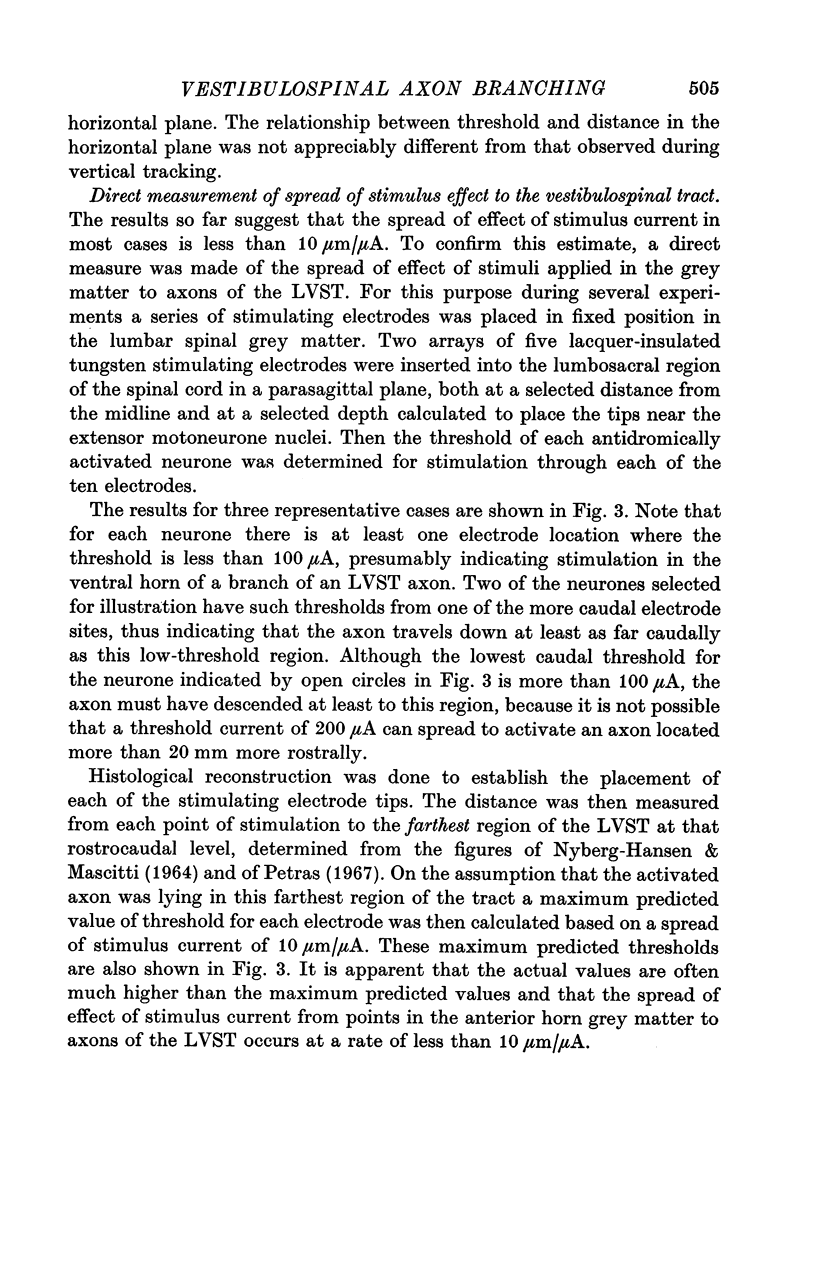
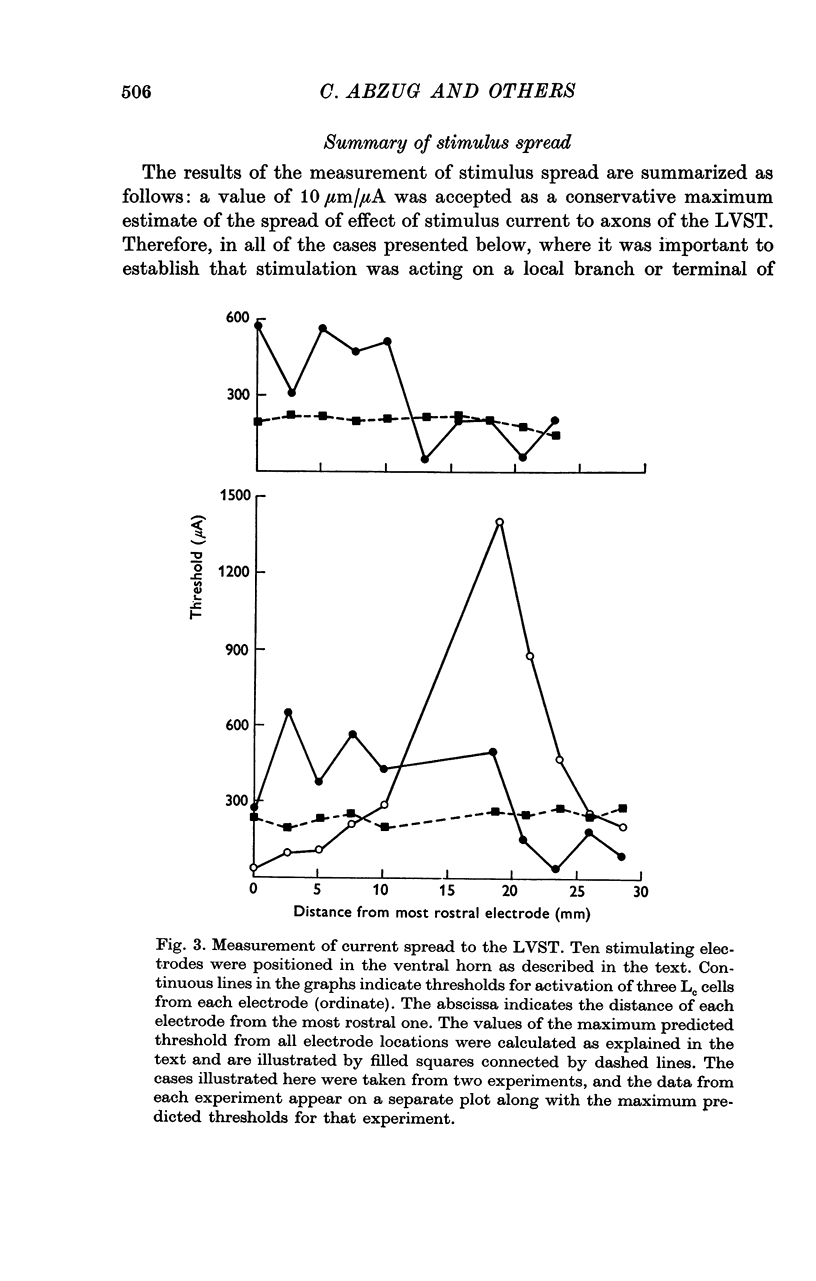
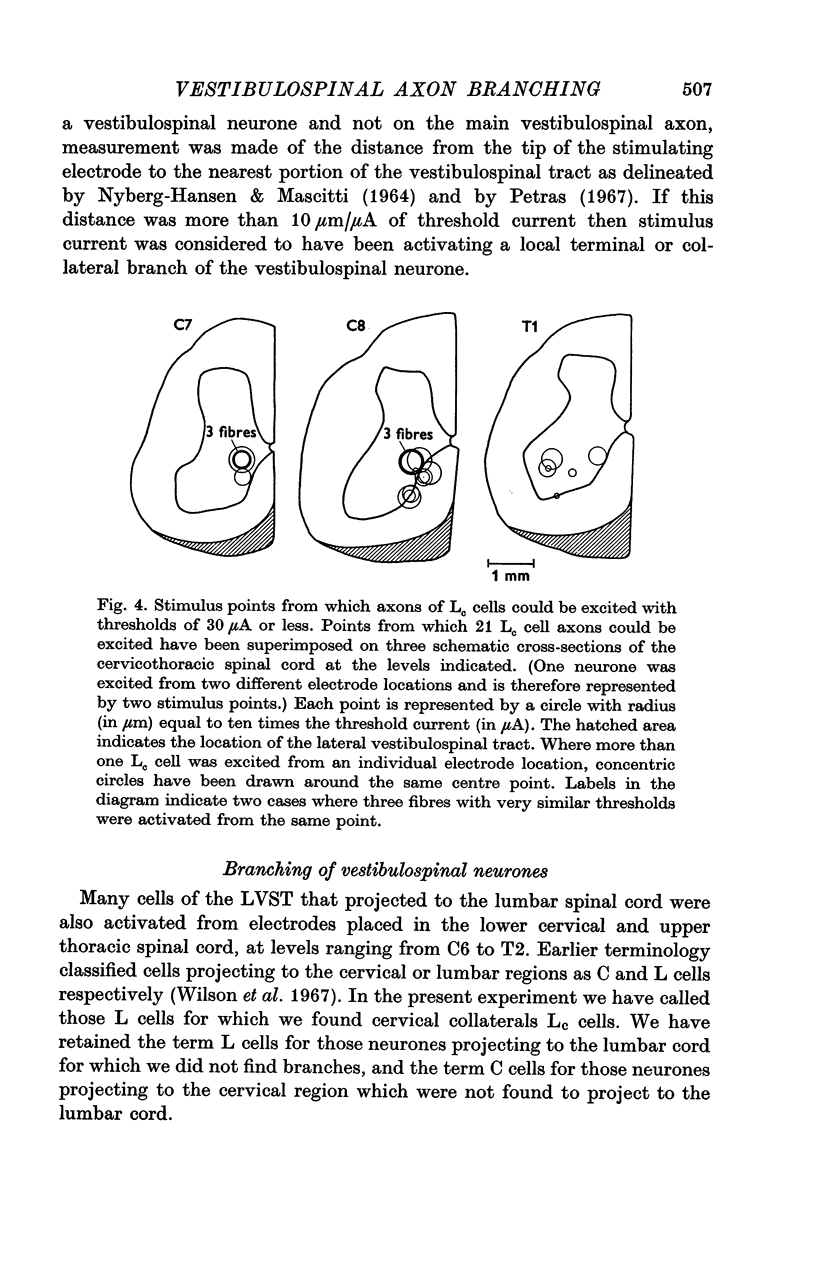
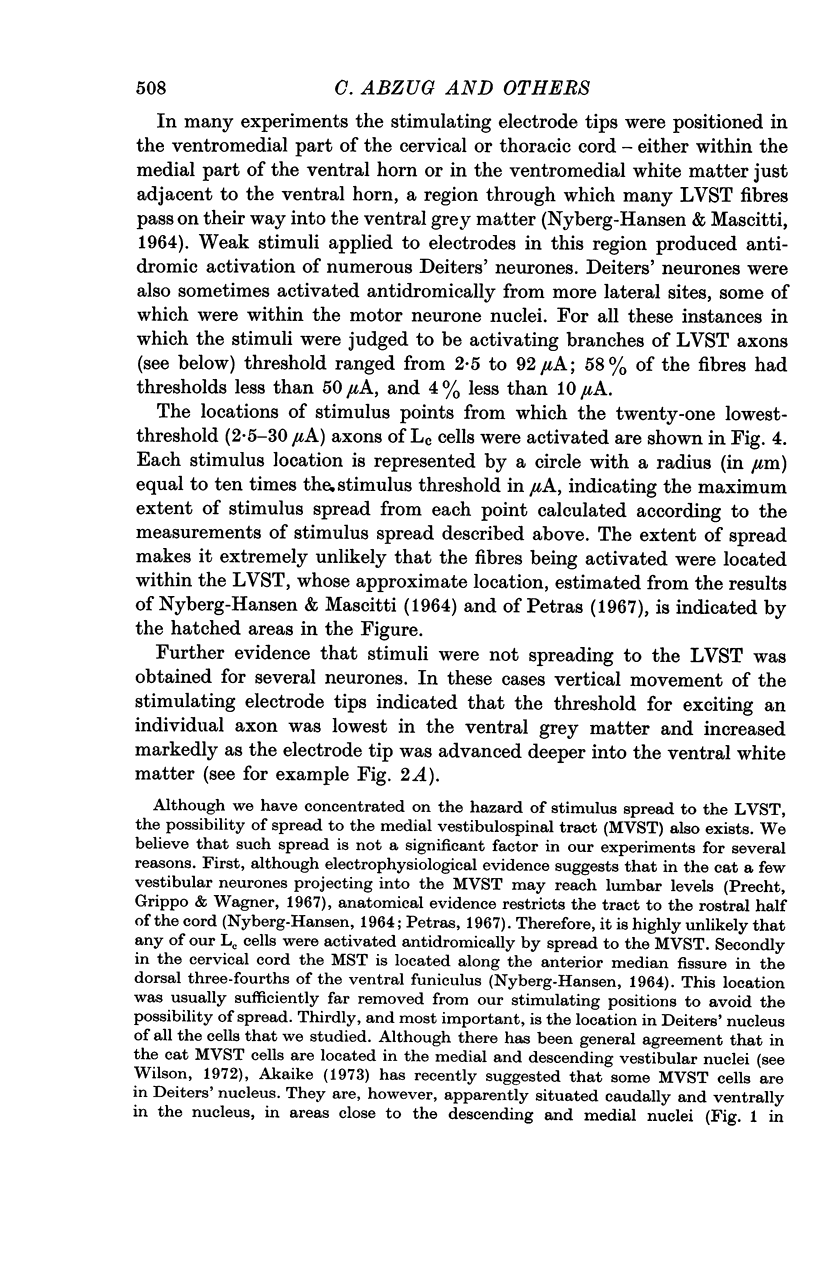
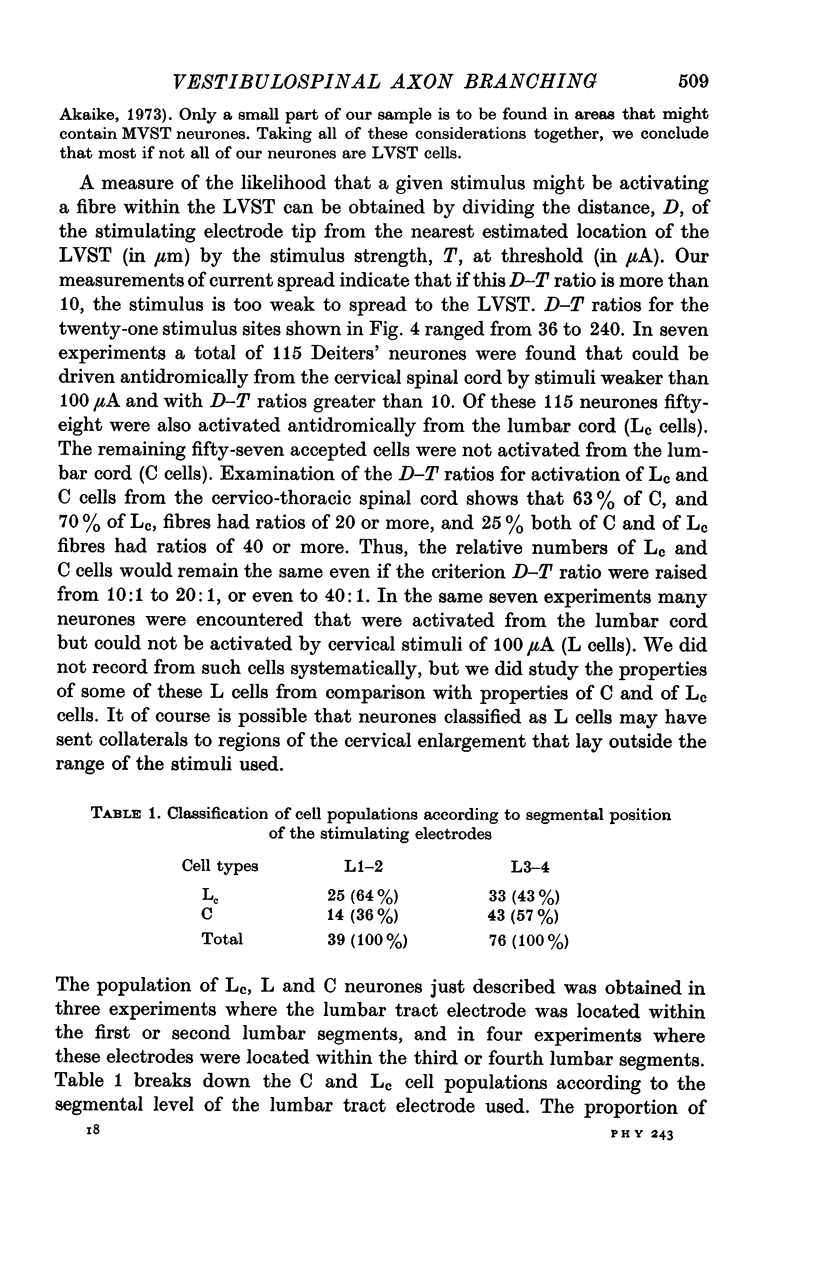
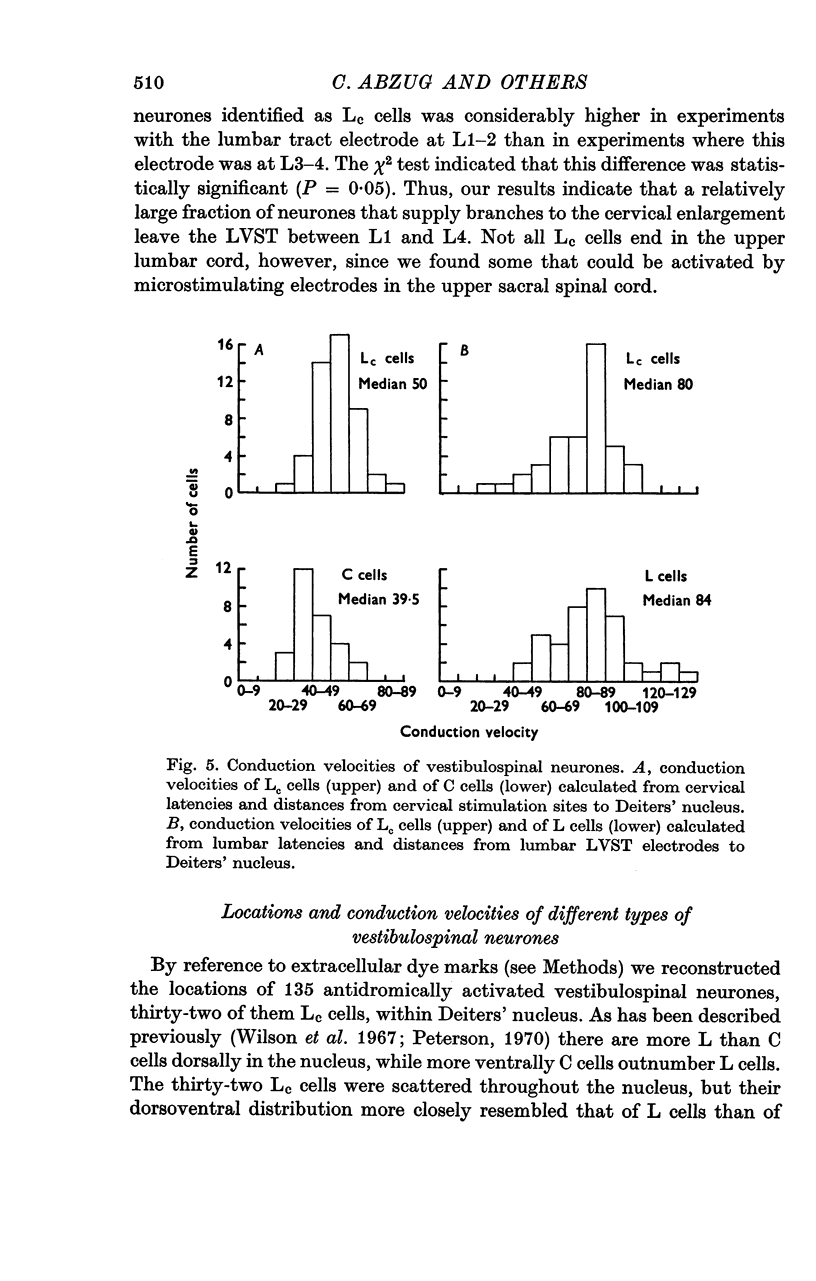
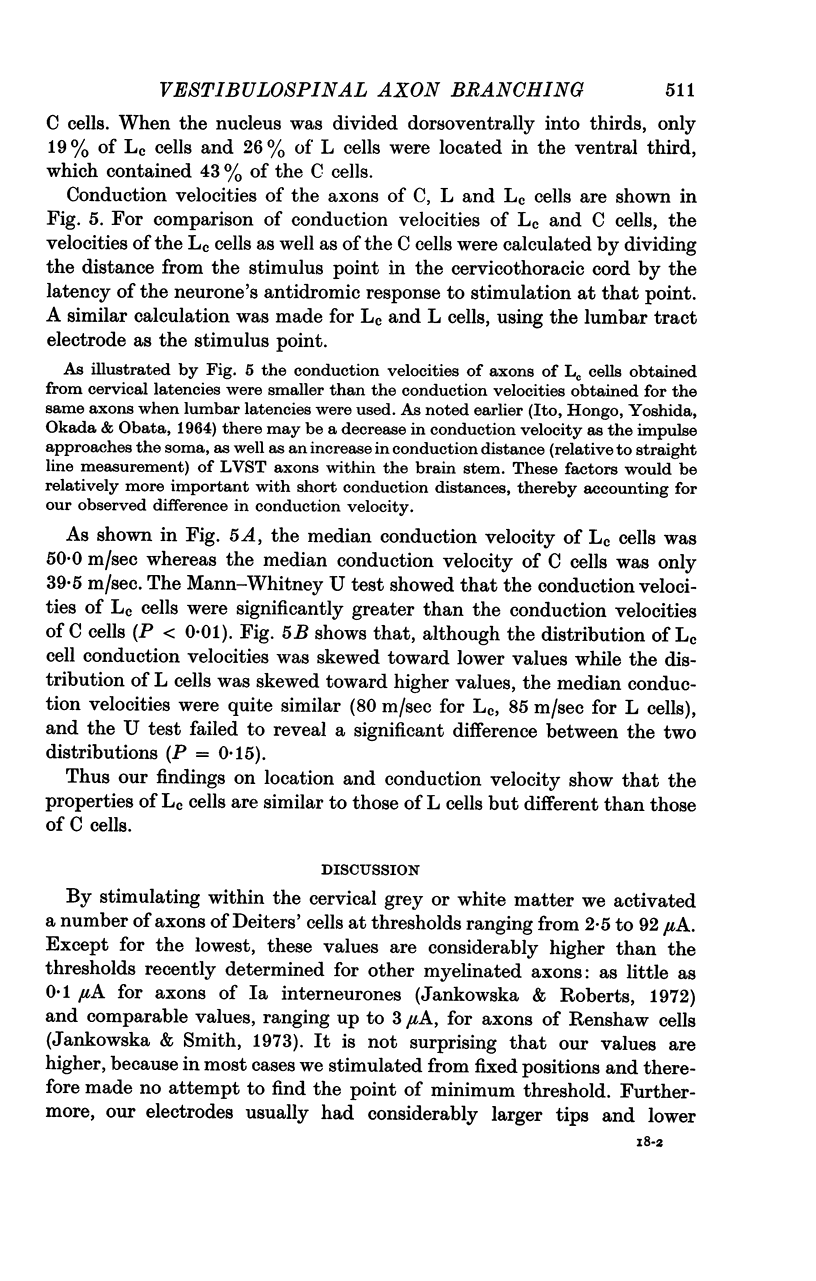
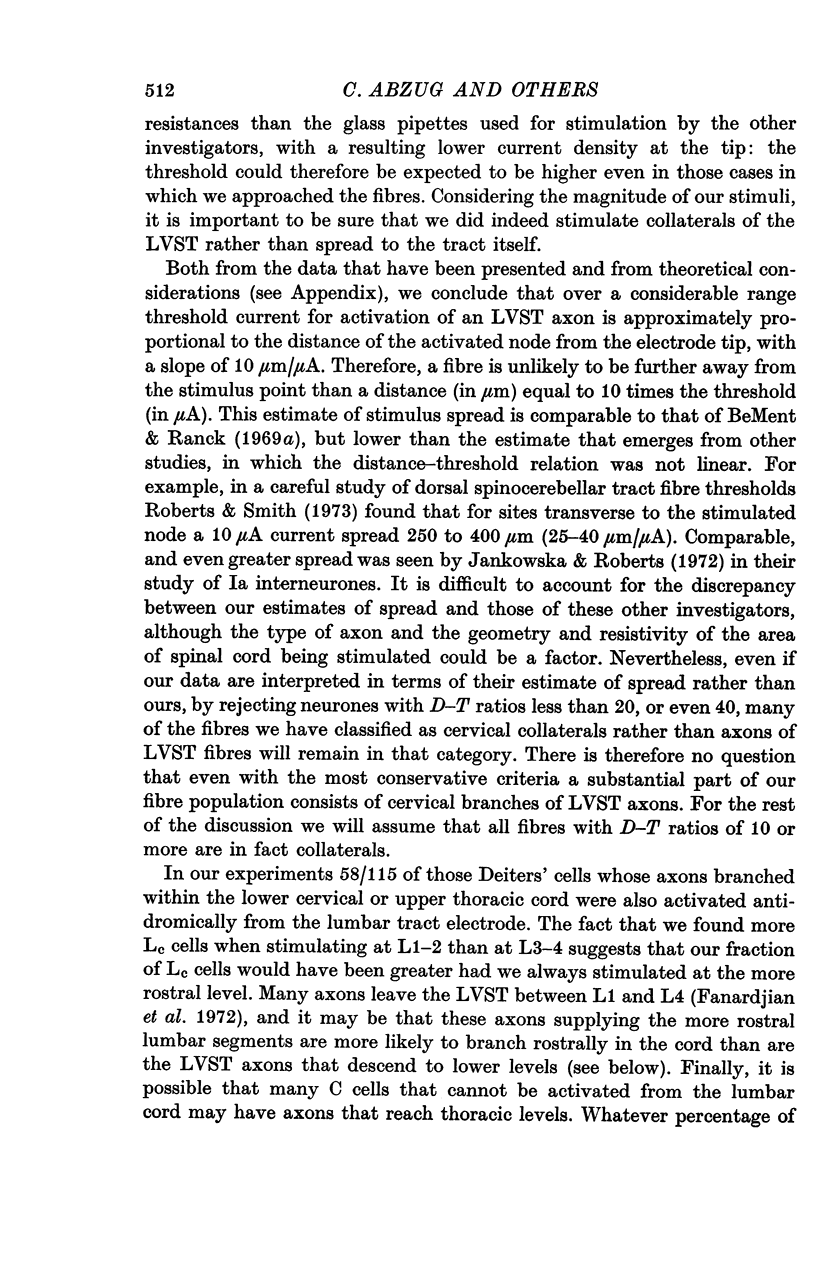
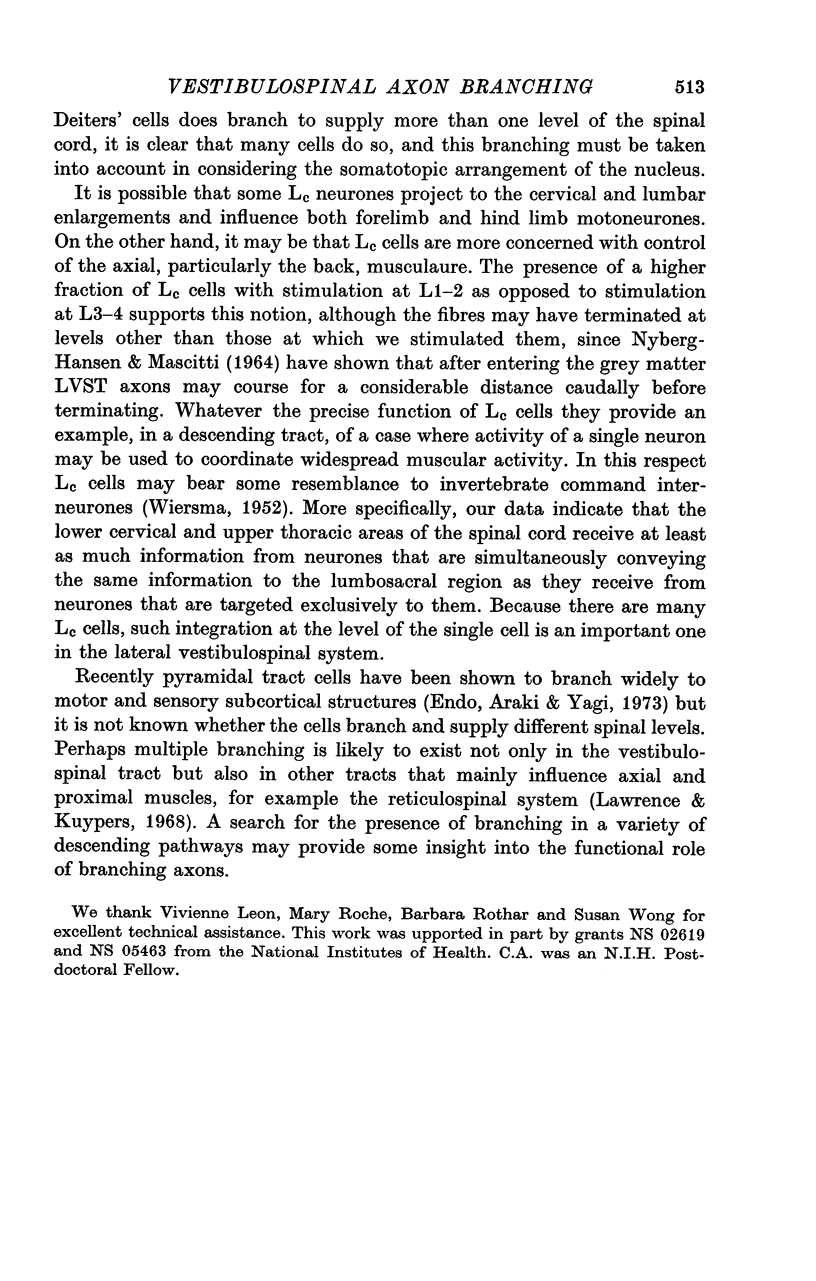
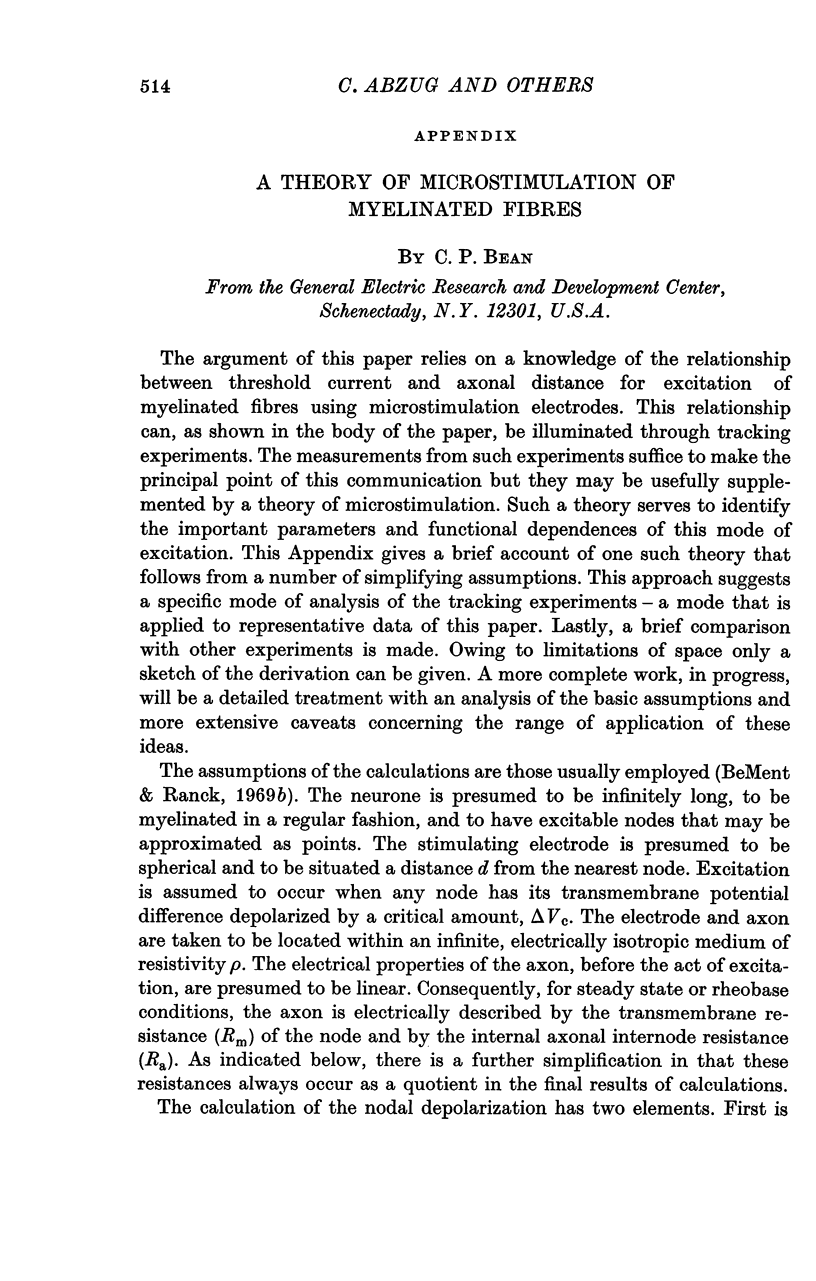
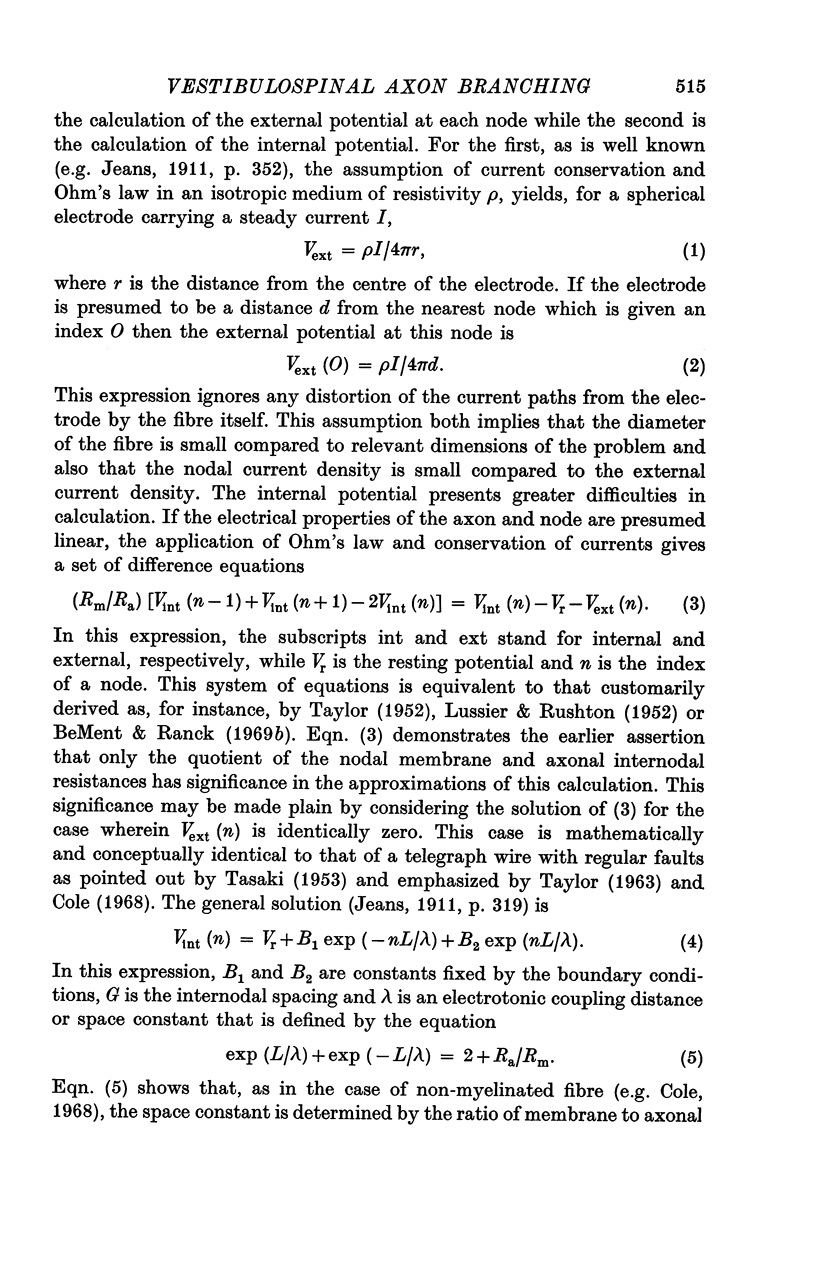
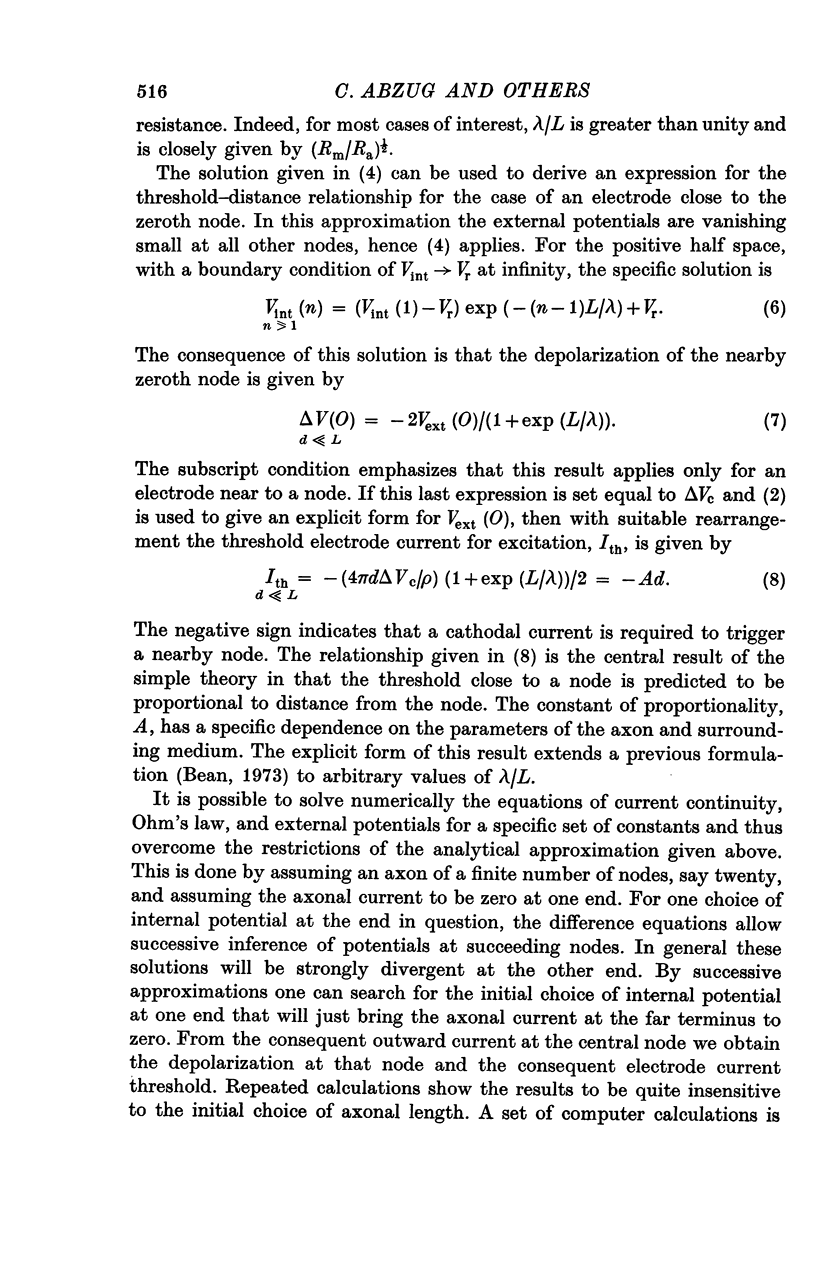
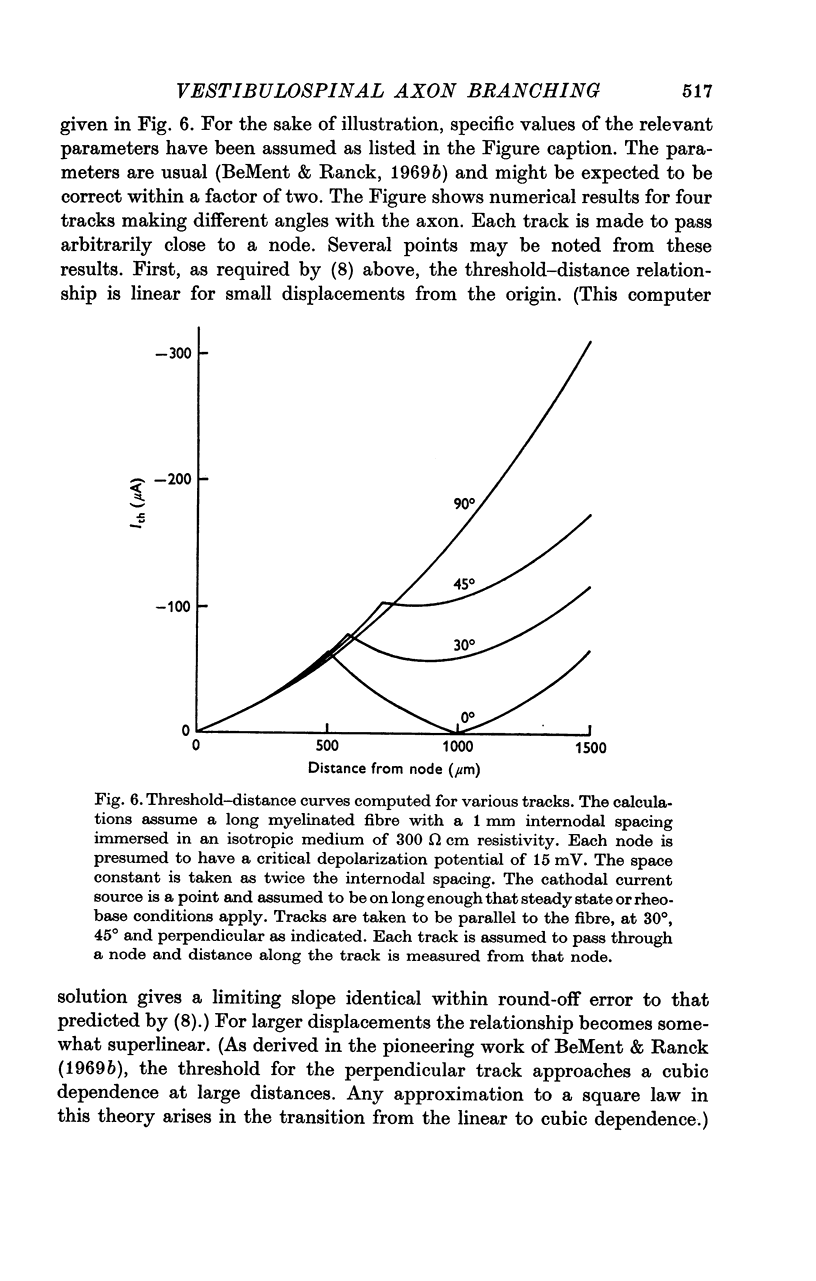
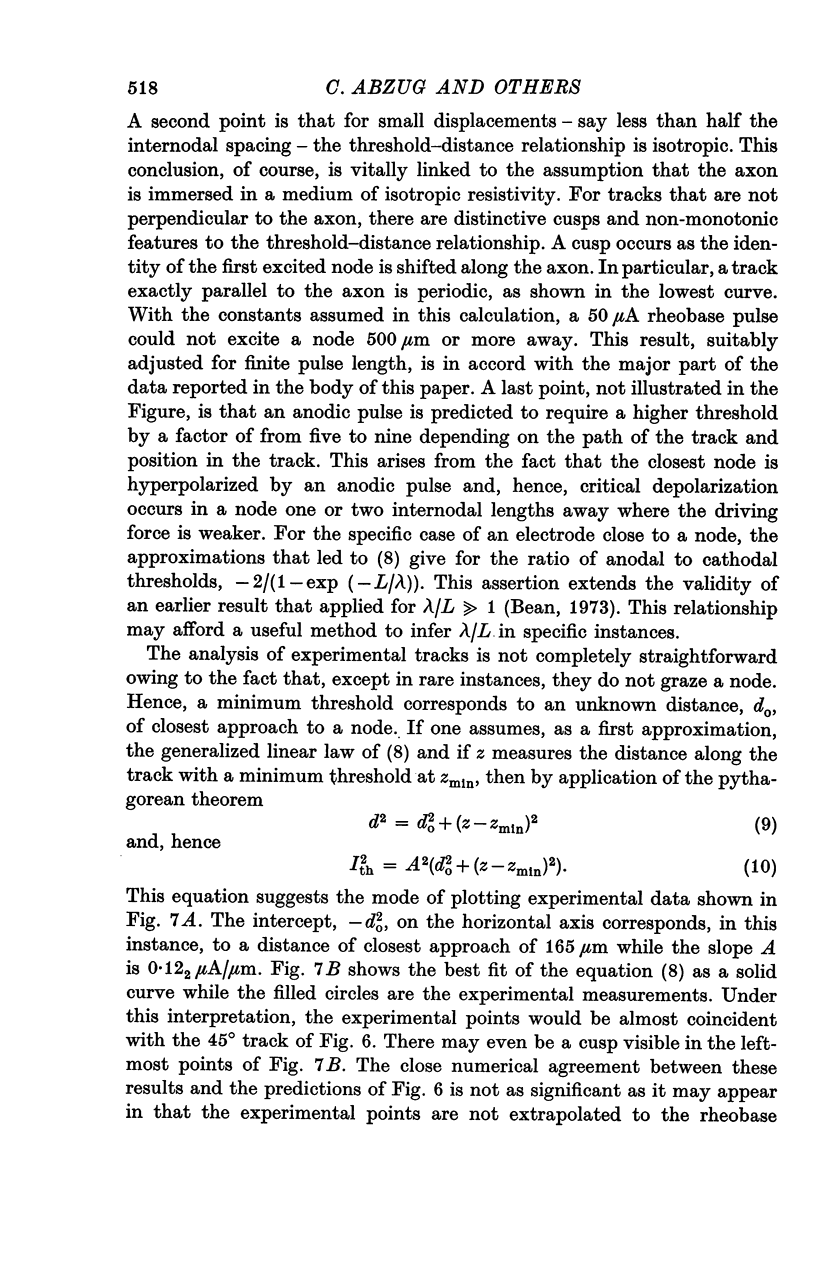
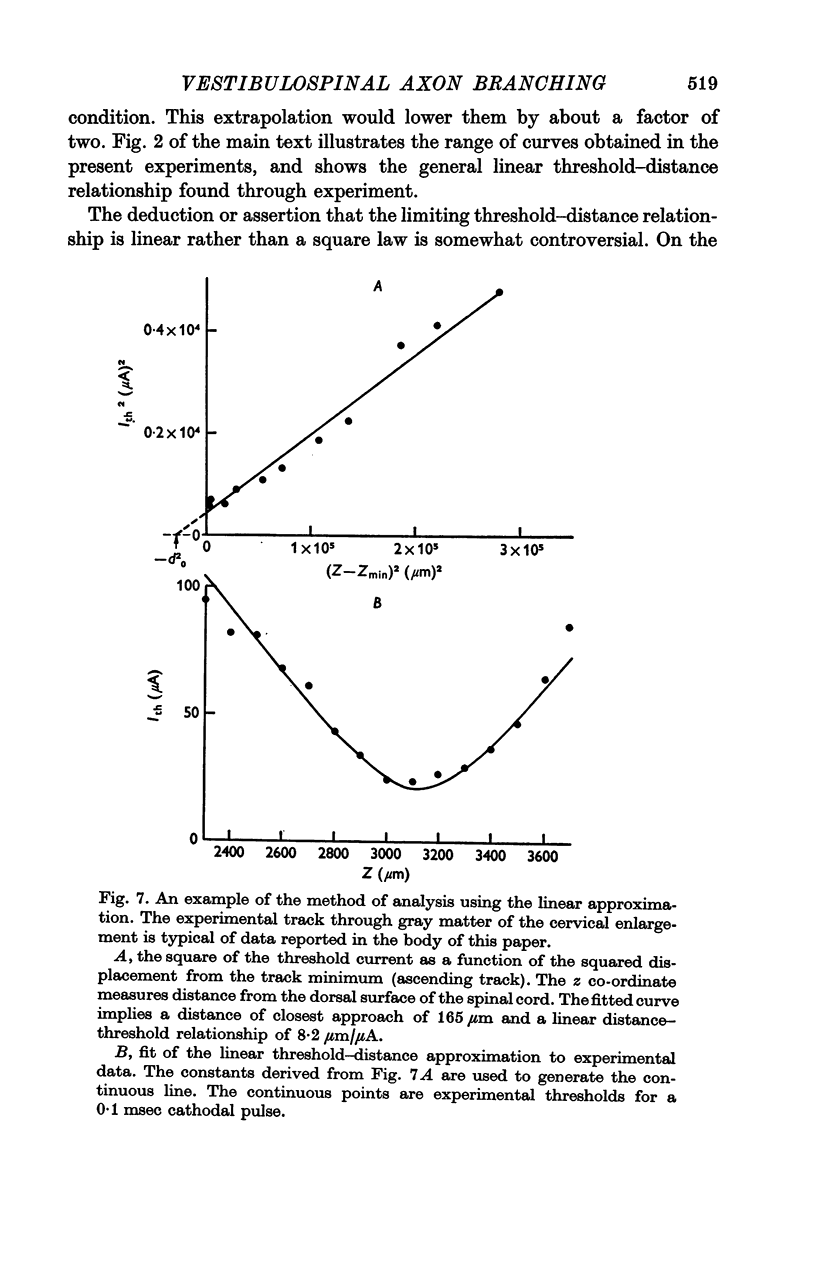
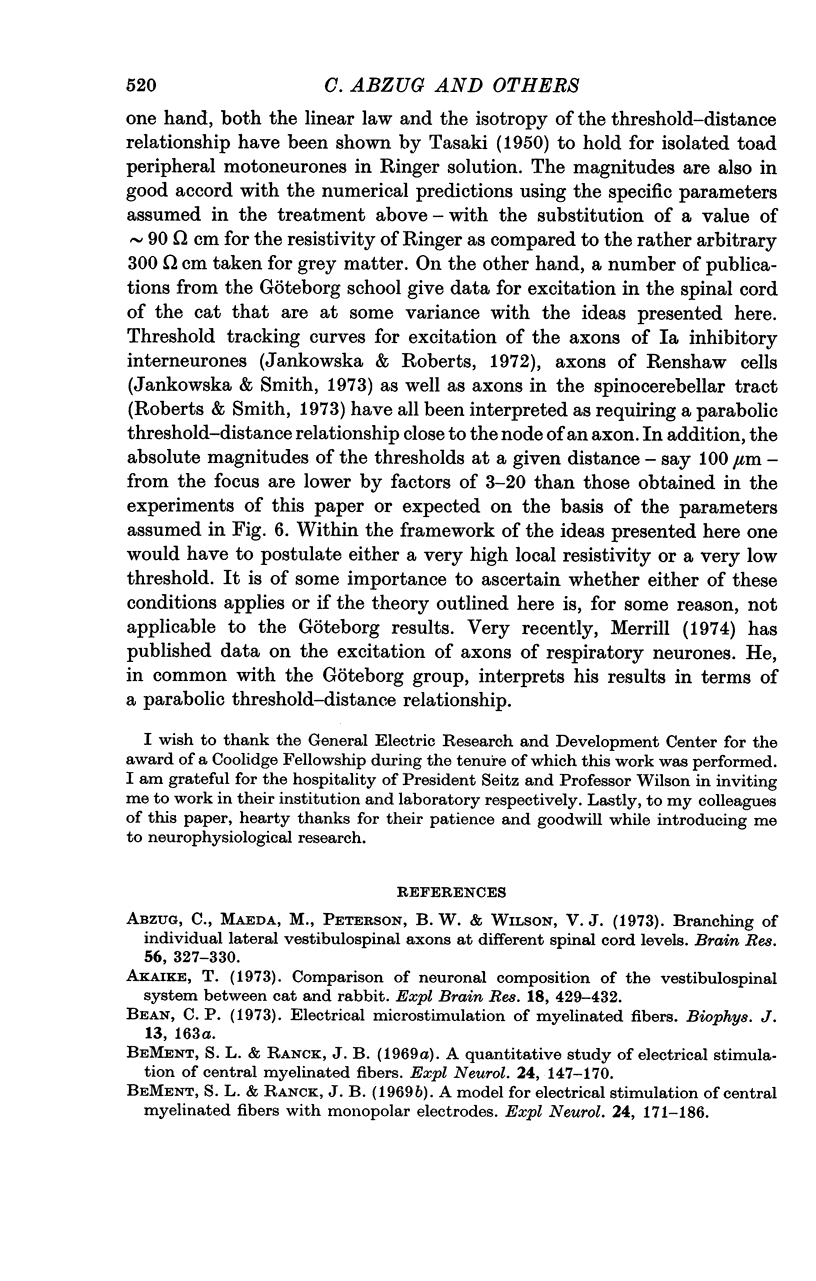
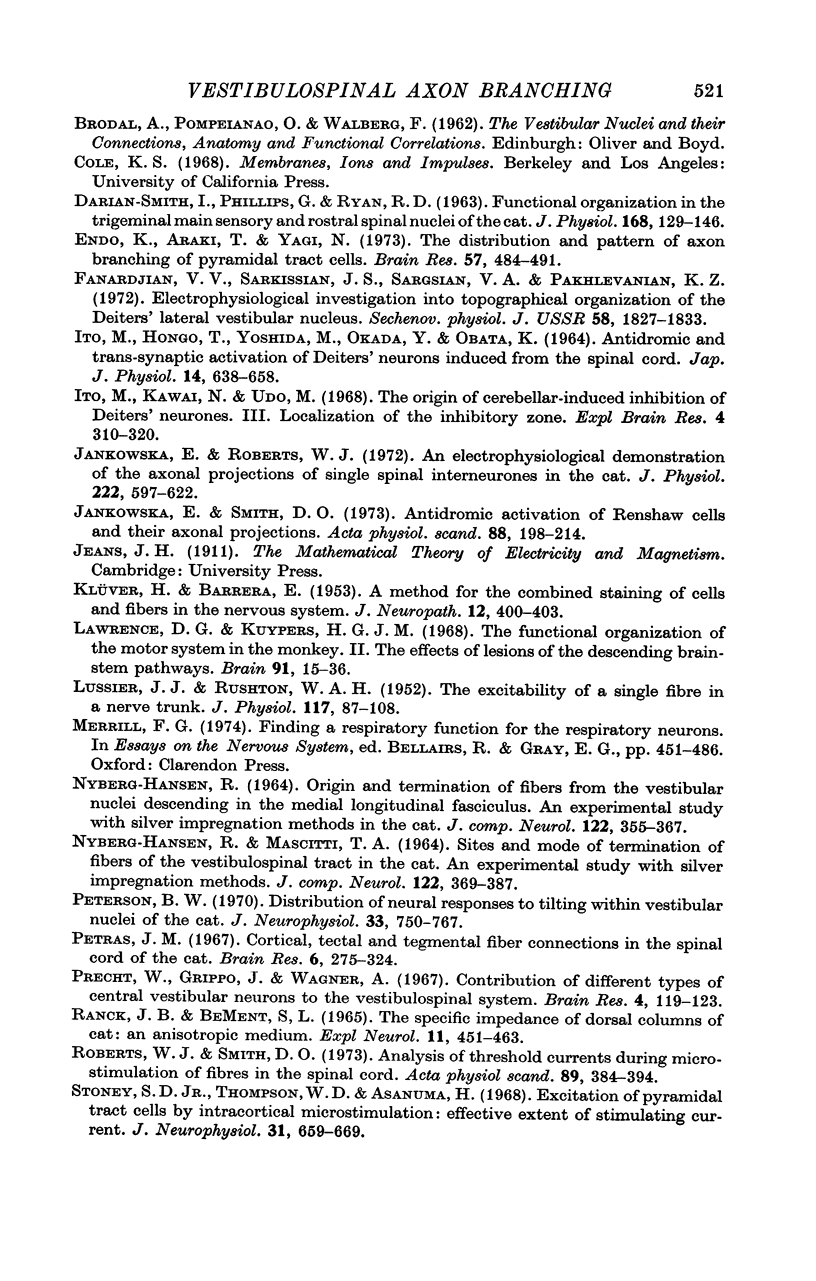
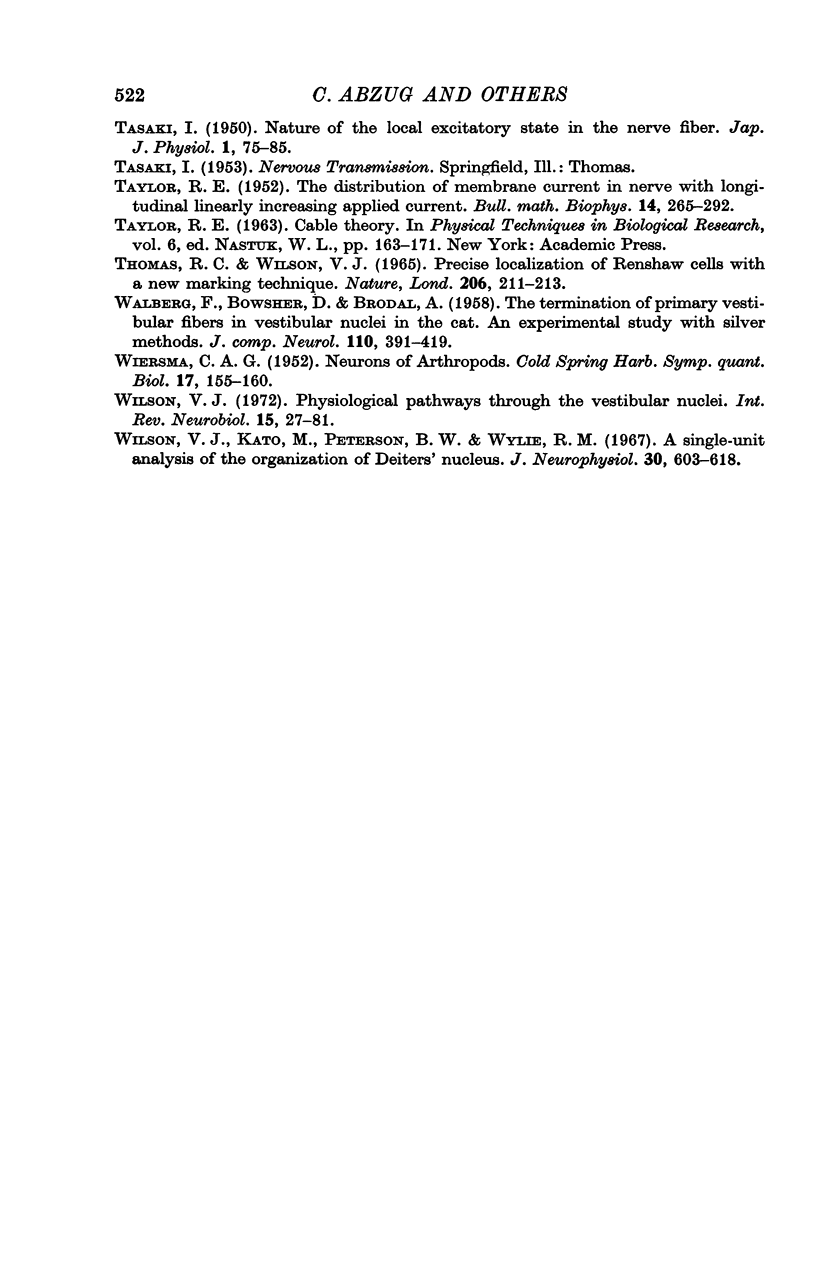
Selected References
These references are in PubMed. This may not be the complete list of references from this article.
- Abzug C., Maeda M., Peterson B. W., Wilson V. J. Branching of individual lateral vestibulospinal axons at different spinal cord levels. Brain Res. 1973 Jun 29;56:327–330. doi: 10.1016/0006-8993(73)90346-6. [DOI] [PubMed] [Google Scholar]
- BeMent S. L., Ranck J. B., Jr A model for electrical stimulation of central myelinated fibers with monopolar electrodes. Exp Neurol. 1969 Jun;24(2):171–186. doi: 10.1016/0014-4886(69)90013-2. [DOI] [PubMed] [Google Scholar]
- BeMent S. L., Ranck J. B., Jr A quantitative study of electrical stimulation of central myelinated fibers. Exp Neurol. 1969 Jun;24(2):147–170. doi: 10.1016/0014-4886(69)90012-0. [DOI] [PubMed] [Google Scholar]
- DARIAN-SMITH I., PHILLIPS G., RYAN R. D. FUNCTIONAL ORGANIZATION IN THE TRIGEMINAL MAIN SENSORY AND ROSTRAL SPINAL NUCLEI OF THE CAT. J Physiol. 1963 Aug;168:129–146. doi: 10.1113/jphysiol.1963.sp007182. [DOI] [PMC free article] [PubMed] [Google Scholar]
- Endo K., Araki T., Yagi N. The distribution and pattern of axon branching of pyramidal tract cells. Brain Res. 1973 Jul 27;57(2):484–491. doi: 10.1016/0006-8993(73)90154-6. [DOI] [PubMed] [Google Scholar]
- Fanardzhian V. V., Sarkisian D. S., Sargsian V. A., Pakhlevanian K. Z. Elektrofiziologicheskoe issledovanie topograficheskoi organizatsii lateral'nogo vestibuliarnogo iadra Deitersa. Fiziol Zh SSSR Im I M Sechenova. 1972 Dec;58(12):1827–1833. [PubMed] [Google Scholar]
- ITO M., HONGO T., YOSHIDA M., OKADA Y., OBATA K. ANTIDROMIC AND TRANS-SYNAPTIC ACTIVATION OF DEITERS' NEURONES INDUCED FROM THE SPINAL CORD. Jpn J Physiol. 1964 Dec 15;14:638–658. doi: 10.2170/jjphysiol.14.638. [DOI] [PubMed] [Google Scholar]
- Ito M., Kawai N., Udo M. The origin of cerebellar-induced inhibition of deiters neurones. 3. Localization of the inhibitory zone. Exp Brain Res. 1968;4(4):310–320. doi: 10.1007/BF00235698. [DOI] [PubMed] [Google Scholar]
- Jankowska E., Roberts W. J. An electrophysiological demonstration of the axonal projections of single spinal interneurones in the cat. J Physiol. 1972 May;222(3):597–622. doi: 10.1113/jphysiol.1972.sp009817. [DOI] [PMC free article] [PubMed] [Google Scholar]
- Jankowska E., Smith D. O. Antidromic activation of Renshaw cells and their axonal projections. Acta Physiol Scand. 1973 Jun;88(2):198–214. doi: 10.1111/j.1748-1716.1973.tb05447.x. [DOI] [PubMed] [Google Scholar]
- KLUVER H., BARRERA E. A method for the combined staining of cells and fibers in the nervous system. J Neuropathol Exp Neurol. 1953 Oct;12(4):400–403. doi: 10.1097/00005072-195312040-00008. [DOI] [PubMed] [Google Scholar]
- LUSSIER J. J., RUSHTON W. A. H. The excitability of a single fiber in a nerve trunk. J Physiol. 1952 May;117(1):87–108. [PMC free article] [PubMed] [Google Scholar]
- Lawrence D. G., Kuypers H. G. The functional organization of the motor system in the monkey. II. The effects of lesions of the descending brain-stem pathways. Brain. 1968 Mar;91(1):15–36. doi: 10.1093/brain/91.1.15. [DOI] [PubMed] [Google Scholar]
- NYBERG-HANSEN R., MASCITTI T. A. SITES AND MODE OF TERMINATION OF FIBERS OF THE VESTIBULOSPINAL TRACT IN THE CAT. AN EXPERIMENTAL STUDY WITH SILVER IMPREGNATION METHODS. J Comp Neurol. 1964 Jun;122:369–383. doi: 10.1002/cne.901220307. [DOI] [PubMed] [Google Scholar]
- NYBERG-HANSEN R. ORIGIN AND TERMINATION OF FIBERS FROM THE VESTIBULAR NUCLEI DESCENDING IN THE MEDIAL LONGITUDINAL FASCICULUS. AN EXPERIMENTAL STUDY WITH SILVER IMPREGNATION METHODS IN THE CAT. J Comp Neurol. 1964 Jun;122:355–367. doi: 10.1002/cne.901220306. [DOI] [PubMed] [Google Scholar]
- Peterson B. W. Distribution of neural responses to tilting within vestibular nuclei of the cat. J Neurophysiol. 1970 Nov;33(6):750–767. doi: 10.1152/jn.1970.33.6.750. [DOI] [PubMed] [Google Scholar]
- Petras J. M. Cortical, tectal and tegmental fiber connections in the spinal cord of the cat. Brain Res. 1967 Oct;6(2):275–324. doi: 10.1016/0006-8993(67)90196-5. [DOI] [PubMed] [Google Scholar]
- Precht W., Grippo J., Wagner A. Contribution of different types of central vestibular neurons to the vestibulospinal system. Brain Res. 1967 Feb;4(1):119–123. doi: 10.1016/0006-8993(67)90158-8. [DOI] [PubMed] [Google Scholar]
- RANCK J. B., Jr, BEMENT S. L. THE SPECIFIC IMPEDANCE OF THE DORSAL COLUMNS OF CAT: AN INISOTROPIC MEDIUM. Exp Neurol. 1965 Apr;11:451–463. doi: 10.1016/0014-4886(65)90059-2. [DOI] [PubMed] [Google Scholar]
- Roberts W. J., Smith D. O. Analysis of threshold currents during microstimulation of fibres in the spinal cord. Acta Physiol Scand. 1973 Nov;89(3):384–394. doi: 10.1111/j.1748-1716.1973.tb05533.x. [DOI] [PubMed] [Google Scholar]
- Stoney S. D., Jr, Thompson W. D., Asanuma H. Excitation of pyramidal tract cells by intracortical microstimulation: effective extent of stimulating current. J Neurophysiol. 1968 Sep;31(5):659–669. doi: 10.1152/jn.1968.31.5.659. [DOI] [PubMed] [Google Scholar]
- Thomas R. C., Wilson V. J. Precise localization of Renshaw cells with a new marking technique. Nature. 1965 Apr 10;206(980):211–213. doi: 10.1038/206211b0. [DOI] [PubMed] [Google Scholar]
- WALBERG F., BOWSHER D., BRODAL A. The termination of primary vestibular fibers in the vestibular nuclei in the cat; an experimental study with silver methods. J Comp Neurol. 1958 Dec;110(3):391–419. doi: 10.1002/cne.901100305. [DOI] [PubMed] [Google Scholar]
- WIERSMA C. A. G. Neurons of arthropods. Cold Spring Harb Symp Quant Biol. 1952;17:155–163. doi: 10.1101/sqb.1952.017.01.015. [DOI] [PubMed] [Google Scholar]
- Wilson V. J., Kato M., Peterson B. W., Wylie R. M. A single-unit analysis of the organization of Deiters' nucleus. J Neurophysiol. 1967 May;30(3):603–619. doi: 10.1152/jn.1967.30.3.603. [DOI] [PubMed] [Google Scholar]
- Wilson V. J. Physiological pathways through the vestibular nuclei. Int Rev Neurobiol. 1972;15:27–81. doi: 10.1016/s0074-7742(08)60328-1. [DOI] [PubMed] [Google Scholar]


